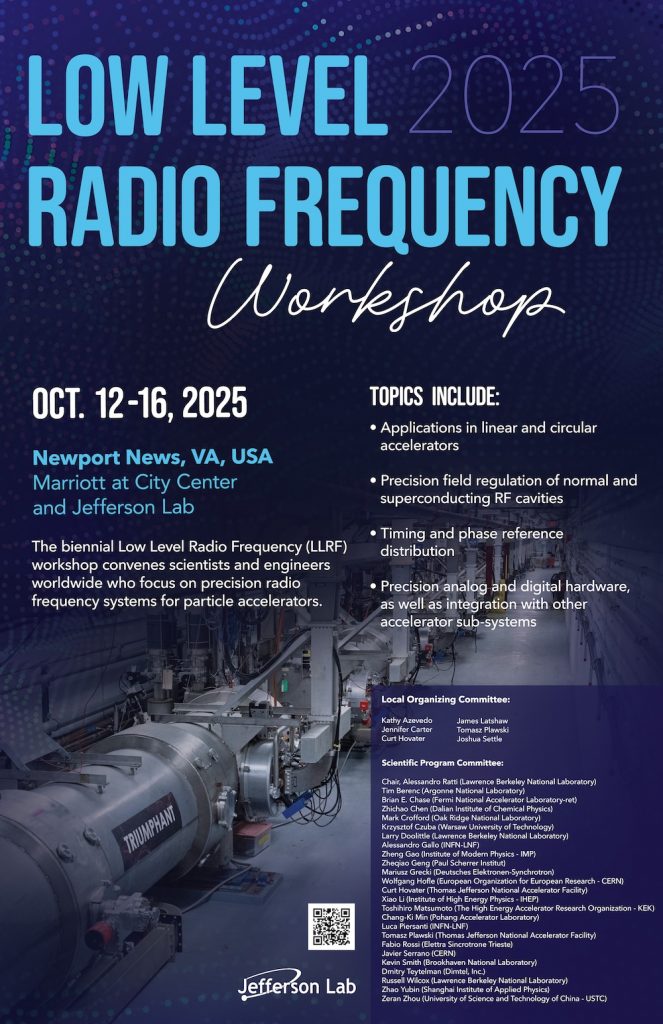
DESY MicroTCA Workshop 2025 (Dec 2-4)

The 14th MicroTCA Workshop for Industry and Research will again take place at the CFEL building on DESY premises from December 2nd to December 4th, 2025.
As a member of the advisory committee, exhibitor, vendor and participant N.A.T. cordially invites you to participate (please follow this link to register) in the MicroTCA Workshop, either on-site at DESY or virtually through the workshop's streaming portal.
The annual MicroTCA Workshop for Industry and Research is the one of the most important events on MicroTCA and targets both users and vendors from international industry and research facilities around the globe.
The main topics of this year's MicroTCA Workshop are:
- Applications in research facilities
- Applications in industry
- New products
- New Technologies
- Future of standard and interoperability
- Software and firmware
- Industry Exhibition - presentation of modules and systems from industry and research
At the 14th MicroTCA Workshop for Industry and Research N.A.T. will present on the following topics
- MicroTCA Tutorial "MicroTCA Management" by Heiko Koerte (Dec 2nd, 09:35 - 10:00)
- "New building blocks and uplink solutions with the NAT-MCH" by Heiko Koerte (Dec 2nd, 17:00 - 17:15)
- "An “industrial server” made of MicroTCA building blocks (& something else)" by Herbert Erd (Dec 3rd, 09:30 - 09:45)
In case you cannot make it to our booth during the daily conference times, please reach out to us and schedule your personal online appointment with either Herbert Erd, Oliver Muenchhoff or Heiko Koerte.
We are looking forward to welcoming and meeting you on-site at DESY.
LLRF Workshop (Oct 12 – Oct 16)
N.A.T. presents MicroTCA based solution for Low Level Radio Frequency (LLRF) control systems for Big Science at the 2025 LLRF Workshop at Jefferson Lab
Bonn/Germany, 24 Septembert 2025 - At the 2025 Low Level Radio Frequency Workshop, Newport News VA, N.A.T. is presenting its MicroTCA based solution for LLRF control systems for Big Science.
MicroTCA is an open industrial standard supported by a large and international eco system. MicroTCA is heavily used by the high-energy and particle physics community. Many low-level radio frequency (LLRF) control systems of international particle accelerators are based on this technology.
Being supplied with longevity guarantees for 15 years and more the modular amd extendable open standard has currently been updated to support 100GbE and PCIexpress gen5 board-to-board speeds.
By its sub-specification MTCA.4, MicroTCA is the only open standard allowing two backplanes in one system. The ability to house both low-noise analogue and digital connections in one create allow customers to reduce space and costs and build efficient systems.
The built-in system management allows remote management of all compenents, i.e. temperature, voltages, currents and other parameters.
Because of its technical features
- high bandwidth in single or dual star topology
- redundant and fail-safe including hot-swap and hot-plug
- precision timing including IEEE1588 and GPS
- low-latency connections for trigger and timing
- low-latency connections for FPGA-to-FPGA communication
- rear-transition modules with optional interconnects by LLRF backplane
- optical or copper system uplinks for broadband Ethernet and PCIexpress
MicroTCA has been the platform choice to build control systems for Big Science appliances such as particle accelerators etc.
At our booth we are showcasing the most recent and fully MicroTCA compliant system in a live demo.
The demonstration visualizes the capabilities of simultaneous data communication through direct point-to-point and switched links.
In addition to the demo we show some selected key components, such as the LLRF backplane, high-end FPGA cards, i.e. NAT-AMC-ZYNQUP-ADV, AC and DC power modules and of course the newest family of generation 4 NAT-MCHs.
Come and see us at the 2025 Low Level Radio Frequency Workshop held at the Marriott at City Center & Jefferson Lab in Newport News,.
MicroTCA Day France 2025 (Sept 17)
N.A.T. will present at the 2025 MicroTCA Day in France
Bonn/Germany, 20 August 2025 - N.A.T. will support the 2025 MicroTCA Day in France, organized by our French partner EMG2, held at IJC Lab (Amphi. Lehmann, Building 200), Orsay-Ville, France, on September 17th, 2025.
MicroTCA is an open industrial, modular and flexible technology resolutely focused on the future. Being supported by a large and international eco system, MicroTCA is heavily used in many applications in all kinde of vertical markets today.
Following the motto MTCA Day: From Science to Industry, this day will be the ideal opportunity to discover or rediscover the fundamental principles of MTCA, understand its technological advantages for your projects, and exchange about its varied applications in the industrial and scientific fields: telecommunications, vision, instrumentation, test benches, acquisition systems, automation, and more.
Join EMG2 and N.A.T. for the 2025 MicroTCA Day to
- Discover the innovations surrounding this fast-growing industrial standard
- Understand its benefits for industrial and scientific applications
- Exchange with the user community
Details about the conference program can be found here.
Please register using this link, if you would like to join us.
📍 Location: IJC Lab (Amphi. Lehmann, Building 200) – View on Google Maps
🚆 Transportation: RER B – Orsay Ville Station (<10 minute walk)
🅿️ Parking: Free
IEEE Quantum Week QCE (Aug 31 – Sept 5)
N.A.T. presents MicroTCA based solution for control systems for Quantum Computing at IEEE QCE at booth of nVent
Bonn/Germany, 20 August 2025 - At IEEE International Conference on Quantum Computing and Engineering (QCE), Albuquerque NM, N.A.T. is presenting its MicroTCA based solution for control systems for Quantum Computer.
MicroTCA is an open industrial standard supported by a large and international eco system. MicroTCA is heavily used by the high-energy and particle physics community. Many low-level radio frequency (LLRF) control systems of international particle accelerators are based on this technology.

Being supplied with longevity guarantees for 15 years and more the modular amd extendable standard has currently been updated to support 100GbE and PCIE gen5 board-to-board speeds.
The ability to house both low-noise analogue and digital connections in one create allow customers to reduce space and costs.
The built-in system management fully manages all compenents in terms of temperature and power (and other parameters), which also enables customers to built energy efficient systems.
Because of its technical features
- high bandwidth in single or dual star topology
- redundant and fail-safe including hot-swap
- precision timing including IEEE1588 and GPS
- low-latency connections for trigger and timing
- low-latency connections for FPGA-to-FPGA communication
- rear-transition modules
- optcial or copper system uplinks
MicroTCA has been the platform choice to build control systems for particle accelerators and quantum computers.
Together with our partner nVent we are showcasing the most recent and fully MTCA.0 r3 compliant system in a live demo.
The demonstration visualizes the capabilities of simultaneous data communication through direct point-to-point and switched links. As a result we are measuring and displaying the latency of both data paths are displayed.
In addition to the demo we show some selected key components, such as high-end FPGA cards, i.e. NAT-AMC-ZYNQUP-ADV, and of course the newest family of generation 4 NAT-MCHs.
Come and see us at the 2025 IEEE International Conference on Quantum Computing and Engineering (QCE)
World of Quantum 2025 (June 23-27)
N.A.T. presents MicroTCA based solution for control systems for Quantum Computing at World of Quantum at booth A1-503 (nVent)
Bonn/Germany, 22 June2025 - At World of Quantum 2025 in Munich, N.A.T. is presenting its MicroTCA based solution for control systems for Quantum Computer.
MicroTCA is an open industrial standard supported by a large and international eco system. MicroTCA is heavily used by the high-energy and particle physics community. Many low-level radio frequency (LLRF) control systems of international particle accelerators are based on this technology.

Being supplied with longevity guarantees for 15 years and more the modular amd extendable standard has currently been updated to support 100GbE and PCIE gen5 board-to-board speeds.
The ability to house both low-noise analogue and digital connections in one create allow customers to reduce space and costs.
The built-in system management fully manages all compenents in terms of temperature and power (and other parameters), which also enables customers to built energy efficient systems.
Because of its technical features
- high bandwidth in single or dual star topology
- redundant and fail-safe including hot-swap
- precision timing including IEEE1588 and GPS
- low-latency connections for trigger and timing
- low-latency connections for FPGA-to-FPGA communication
- rear-transition modules
- optcial or copper system uplinks
MicroTCA has been the platform choice to build control systems for particle accelerators and quantum computers.
Together with our partner nVent we are showcasing the most recent and fully MTCA.0 r3 compliant system in a live demo.
The demonstration visualizes the capabilities of simultaneous data communication through direct point-to-point and switched links. As a result we are measuring and displaying the latency of both data paths are displayed.
In addition to the demo we show some selected key components, such as high-end FPGA cards, i.e. NAT-AMC-ZYNQUP-ADV, and of course the newest family of generation 4 NAT-MCHs.
Come and see us at stand A1.503 at World of Quantum 2025.
VISION 2024 (Oct 8-10)
Offical launch of NATvision solutions at booth 10H46 in hall 10 - Free tickets available
Bonn/Germany, October 2024 - At VISION 2024, N.A.T. launches its hybrid and modular NATvision platform where we combine the best of FPGA (Field Programmable Gate Array) and CPU ( X86 / ARM) for real-time imaging data analytics and processing.
Please join us in hall 10 at booth 10H46 and experience our life demos covering real-time Vision examples as well as an AI supported object detection and -tracking system to get detailed information about our latest products around the NATvision platform.
Your free exhibition ticket is available here:
Simply use the promotion code 10H46NATvision and get your free ticket.
NATvision is modular
NATvision is built on AMD ZYNQ Ultrascale+ MPSocs for faster and energy-efficient preprocessing and different FMC Modules to support the required camera interfaces. Depending on the customer's needs, the MPSoCs are available in different variants. IEEE1588 for high-precision time synchronization of all connected cameras is supported naturally.
The in-house GigEVision camera-stack for the FPGA cards is modular as well, so the platform can be adapted to individual tasks and transmission speeds.
Moreover, NATvision can be supplemented with additional processors and AI accelerators from NAT and other Vendors who support the open industrial standards from PICMG and VITA around AMC/MTCA and FMC/FMC+ specification.
NATvision is scalable
Up to 12 FPGA cards can be combined in one MTCA system, so enormous amounts of data can be transferred flexibly between these modules via the highspeed backplane. The system is suitable for connections with a data throughput of up to 100 GbE per camera.
Wide range of applications
As NATvision enables the use of high-resolution, high-end cameras for inspection, quality control, and monitoring, the system aims at the entire value chain of industrial companies - from development and production to packaging. Applications may be analyzing off-rollable meterage, printed items, and bulk materials as well as semiconductors and electronic assemblies.
Another field of application is aerospace and automotive testing e.g., material stress tests, crash tests, airbag dynamics, aerodynamics, combustion processes in engines, or thermal measurement.
NATvision is also suited for safety and security applications like accident prevention in intelligent transport systems (e.g. railway technology), medical imaging (e.g. X-ray), and science/research (physics, chemistry, and biology/biomechanics).
Live demo
The performance of the new real-time FPGA-based NATvision platform in high-speed/high-res vision applications will be demonstrated using a live demo that captures and visualizes the trajectory of a ball in real time.
NATvision enables calculated trajectory predictions to be made, on the basis of which corresponding trigger and output signals can be initiated. Motion control systems can use such calculations to precisely identify goods that are recognized as faulty e.g., to exclude them from the further production process at the appropriate point using a generated trigger.
As part of the live demo, the image data is recorded with a 4K Ultra HD GigEVision camera with a resolution of 3,840 x 2,160 pixels at a frame rate of up to 180 frames/sec. Digital video data streams of up to 35 Gbit/s per camera stream are transmitted and processed in the FPGA using N.A.T.'s own GigEVision firmware package. These data are then available for further FPGA-based processing as an AXI stream. Finally, the video data is written to the RAM of the FPGA-integrated ARM cores – which support Linux – via DMA. From there, data can be transferred to other boards @ 64/128 GTPS or external nodes with up to 2 x 100 GbE via the system uplinks. GPUs and AI accelerators can also be integrated as additional cards.
Currently, each FPGA card can receive and process up to 40Gb/s of image data per camera. This value will increase to 100Gb/s in future. The measured processing latency in the FPGA for the complete preprocessing is less than 500ns, while the processing speed is deterministic in every configuration.
Components of the NATvision platform:
- NATIVEserver, an embedded NATvision system with integrated CPU, eMCH, PM, and up to 4 FPGA card slots
- NAT-AMC-ZYNQUP-ECO with Xilinx ZynqUP ZU2 – ZU5 MPSoC
- NAT-AMC-ZYNQUP-ADV with Xilinx ZynqUP ZU7 – ZU11
- NAT-FMC-PoE and NAT-FMC-HDMI
- NAT-FMC-SFP
- A NATvision Board Support Package (BSP) including GigEVision stack, GenICam, and sample applications for development teams
IEEE Quantum Week QCE 2024 (Sept 15-20)
N.A.T. presents MicroTCA based solution for control systems for Quantum Computing at IEEE QCE at booth 405 (nVent)
Bonn/Germany, 23 August 2024 - At IEEE International Conference on Quantum Computing and Engineering (QCE), N.A.T. is presenting its MicroTCA based solution for control systems for Quantum Computer.
MicroTCA is an open industrial standard supported by a large and international eco system. MicroTCA is heavily used by the high-energy and particle physics community. Many low-level radio frequency (LLRF) control systems of international particle accelerators are based on this technology.

Being supplied with longevity guarantees for 15 years and more the modular amd extendable standard has currently been updated to support 100GbE and PCIE gen5 board-to-borad speeds.
The ability to house both low-noise analogue and digital connections in one create allow customers to reduce space and costs.
The built-in system management fully manages all compenents in terms of temperature and power (and other parameters), which also enables customes to built energy efficient systems.
Because of its technical features
- high bandwidth in single or dual star topology
- redundant and fail-safe including hot-swap
- precision timing including IEEE1588 and GPS
- low-latency connections for trigger and timing
- low-latency connections for FPGA-to-FPGA communication
- rear-transition modules
- optcial or copper system uplinks
MicroTCA has been the platform choice for many accelerator control groups.
Together with our partner nVent we will showcase a life system as well as some well selected key components, i.e. high-end FPGA cards.
Come and see us at stand 405 at the IEEE International Conference on Quantum Computing and Engineering (QCE).
Embedded World 2024 (Apr 9-11)
N.A.T. presents FPGA-based vision platform for real-time imaging data analytics of multiple high-end cameras at stand 1-211 in hall 1
Bonn/Germany, 20 March 2024 - At Embedded World 2024, N.A.T. is presenting NATvision, its new real-time capable, FPGA-based vision platform for high-resolution, high-end cameras based on the MicroTCA standard (Embedded World). NATvision is the world's first platform of its kind that fully utilizes AMD's (formerly Xilinx) ZYNQ UltraScale+ MPSoC FPGA technology for the processing and analysis of imaging data streams from high-performance video cameras.
NATvision enables developers and system integrators to process imaging data streams from multiple high-resolution, high-end cameras in real time on a single consolidated platform. NATvision stands out from conventional PC-based vision platforms by utilizing faster and more energy-efficient FPGA technology, which can be modularly adapted to the individual processing tasks and a wide variety of transmission protocols as required. Thanks to the scalability of NATvision, up to twelve FPGA cards per system can be combined in a single system. The system is suitable for connecting cameras with a data throughput of up to 100 GbE.

Wide range of applications
NATvision is based on the open MicroTCA standard, which achieves a very high degree of modularity and at the same time allows enormous amounts of data to be transferred flexibly between all of the system's plug-in cards via its high-speed backplane. Thanks to its modularity, every NATvision system can be supplemented with additional processors and AI accelerators. NATvision naturally supports time synchronization using IEEE1588 to ensure high-precision time synchronization of all connected cameras. This makes NATvision the ideal solution for image processing with high frame rates and high image resolutions in real time.
NATvision enables the use of high-resolution, high-end cameras for inspection, quality control and monitoring across the entire value chain of industrial companies - from development and production to packaging, as well as in safety and security applications. Vertical markets can be found in industrial production (e.g. analyzing off-rollable meterage, printed items, and bulk materials as well as semiconductors and electronic assemblies), aerospace and automotive testing (e.g. material stress tests, crash tests, airbag dynamics, aerodynamics, combustion processes in engines, thermal measurement). Other applications include accident prevention systems in intelligent transport systems (e.g. railway technology), medical imaging (e.g. X-ray) and science/research (physics, chemistry, biology/biomechanics).
The technology in detail
The FPGA-based NATvision vision system from N.A.T., which is being presented for the first time at Embedded World, can be equipped with one to twelve FPGA cards to suit specific requirements and applications. The performance of the AMD ZYNQ UltraScale+ MPSoC processors can be scaled from 103,000 to 1.143 million logic cells, depending on requirements. The design of the in-house GigEVision firmware package for the FPGA cards is also modular, so that other camera interfaces such as CoaXPress can be easily integrated instead of GigEVision. The sample applications supplied with NATvision and the GenICam-compatible SDK enable users to quickly commission the system and integrate it into their own software routines. N.A.T. is currently working with a partner to add AI functionality to the system. The system chassis comes from partner nVent, which is also presenting the demo system at its Embedded World stand 211 in hall 1.
Live demo
The performance of the new real-time FPGA-based NATvision platform in high-speed/high-res vision applications will be demonstrated using a live demo that captures and visualizes the trajectory of a ball in real time. NATvision enables calculated trajectory predictions to be made, on the basis of which corresponding trigger signals can be initiated. Motion control systems can use such calculations to precisely identify goods that are recognized as faulty, e.g. to exclude them from the further production process at the appropriate point using a generated trigger.As part of the live demo, the image data is recorded with a 4K Ultra HD GigEVision camera with a resolution of 3,840 x 2,160 pixels at a frame rate of up to 180 frames/sec. Digital video data streams of up to 35 Gbit/s are transmitted and processed in the FPGA using N.A.T.'s own GigEVision firmware package. These data are then available for further FPGA-based processing as an AXI stream. Finally, the video data is written to the RAM of the FPGA-integrated ARM cores – which support Linux – via DMA. From there, data can be transferred to external nodes at up to 100Gbps via the system uplinks, for example. GPUs and AI accelerators can also be integrated as additional cards. Currently, each FPGA card can receive and process up to 40Gb/s of image data from up to four cameras. This value will increase to 100Gb/s per card in future. The measured processing latency in the FPGA is less than 500ns, while the processing speed is deterministic in every configuration.
Camera manufacturers, inspection system developers and system integrators can find more information about NATvision from N.A.T. and the service offering at https://nateurope.com/solution/natvision/
DESY MicroTCA Workshop 2023 (Dec 5-7)

The 12th MicroTCA Workshop for Industry and Research will again take place at the CFEL building on DESY premises from December 5th to December 7th 2023.
As a member of the advisory committee, exhibitor, vendor and participant N.A.T. cordially invites you to participate (please follow this link to register) in the MicroTCA Workshop, either on-site at DESY or virtually through the workshop's streaming portal.
The annual MicroTCA Workshop for Industry and Research is the one of the most important events on MicroTCA and targets both users and vendors from international industry and research facilities around the globe.
The main topics of this year's MicroTCA Workshop are:
- Applications in research facilities
- Applications in industry
- New products
- New Technologies
- Future of standard and interoperability
- Software and firmware
- Industry Exhibition - presentation of modules and systems from industry and research
At the 12th MicroTCA Workshop for Industry and Research N.A.T. will present on the following topics
- MicroTCA Tutorial: "MicroTCA Management, Clocking and Fabrics" by Heiko Koerte (Dec 5th, 9:35 - 10:00am CET)
- "NAT-MCH Generation 4 - new features and how to transit from NAT-MCH Generation 3" by Heiko Koerte (date and time to be confirmed)
- "NATIVE-server: from concept to solution" by Herbert Erd (date and time to be confirmed)
In case you cannot make it to our booth during the daily conference times, please reach out to us to schedule your personal online appointment with either Herbert Erd or Heiko Koerte.
We are looking forward to welcoming and meeting you on-site at DESY.
Students and Career Day 2023 at HBRS (Nov 9)
N.A.T. is a highly innovative and owner-led company located right on the banks of the River Rhine in Bonn-Oberkassel.
Since 1990 we are developing high-tech products for wire, fibre, and radio based applications in telecommunication and industrial automation.
Based on the most recent open standards our board and system solutions are continously developed further using state-of-the-art technologies to serve our highly appreciating international customer base.
However, at N.A.T. we honestly believe that such solutions can be created only when enjyoing work and the responsibility everyone has for the entire team.
For our growing software and hardware engineering teams we are always looking for talented and motivated students and graduates of computer science and engineering. Find details for your application here: https://nateurope.com/vacancies
On November 9th, 2023 at stand H at the "Unternehmenstag 2023" at Hochschule Bonn-Rhein-Sieg in Sankt Augustin, you have the opportunity to get first-hand experience and discuss your career with our VP and Director Sales & Marketing Heiko Körte.
Come and see us at stand H to get your personal information package on externship semesters, bachelor and master theses or your career start at our corporate headquarters in Bonn.
We are looking forward to seeing you!




